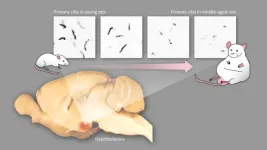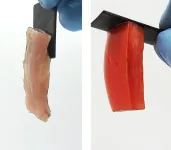(Press-News.org) Americans already living in housing supported by federal housing assistance programs have significantly lower blood lead levels than counterparts who would later join these programs, according to new research led by environmental health scientists at Columbia University Mailman School of Public Health and Tufts Medical Center. The findings appear in the peer-reviewed journal Environmental Health Perspectives.
“Living in federally-supported housing—especially public housing—limited opportunities for residents’ exposure to lead,” says first author MyDzung Chu, Ph.D., assistant professor in the Institute for Clinical Research and Health Policy Studies at Tufts Medical Center. “This likely relates to stricter compliance and enforcement of federal residential lead paint laws in HUD housing compared to non-assisted housing in the private market.”
“Federal housing assistance is an important social-structural safety net for very low-income households to access both affordable and safe, healthy housing,” adds senior author Ami Zota, PhD, associate professor of environmental health sciences at Columbia University Mailman School of Public Health. “Lead is a major health risk at any level of exposure.”
The new study is the first to examine blood lead levels (BLLs) by federal housing assistance status in a nationally representative sample of HUD-eligible adolescents and adults. Researchers used the 1999-2018 National Health and Nutrition Examination Survey (NHANES) linked with housing records from the U.S. Department of Housing and Urban Development (HUD) to compare BLLs of NHANES participants on housing assistance (a total of 3,071) at the time of the survey and those who would receive assistance within two years after the survey (i.e., pseudo-waitlist recipients, a total of 1,235).
Participants living with HUD housing assistance had 11.4 percent lower BLLs than those in the pseudo-waitlist group. They also had 40 percent lower odds of having a BLL greater than or equal to 3.5 µg/dL—a level used to identify children with BLLs higher than those of most U.S. children, determine appropriate follow-up actions, and prevent further exposure. These numbers were adjusted to account for demographic and socioeconomic confounders.
Additional findings:
Comparing three main HUD housing assistance programs, public housing was the most protective against lead exposure followed by multifamily income-restricted housing. No protective effect was seen for tenant-based housing choice vouchers (HCVs). HUD enforces more stringent lead control strategies in public housing units, which provide more long-term/permanent solutions to reduce lead exposure, such as requiring lead-based paint inspections and lead abatement for affected units. In contrast, tenant-based rental assistance programs like HCVs only require that HCV-eligible units undergo a visual assessment and lead paint stabilization if lead is found, which are considered short-term/interim controls and thus less effective.
The link between HUD housing assistance and BLLs was weaker for non-Hispanic Black and Mexican American participants than for non-Hispanic Whites. This discrepancy could be due to Black and Mexican American individuals’ exposure to other lead sources, such as lead-contaminated drinking water and proximity to industrial pollution, though authors could not directly assess these sources in the NHANES or HUD data. Moreover, Black households face barriers to high quality housing due to legacies of racist housing policies and urban planning practices. Black families receiving vouchers tend to live in more disadvantaged, racially segregated, and overcrowded neighborhoods compared to White families receiving vouchers. The researchers say more attention is needed to ensure quality housing and racial equity across HUD’s housing assistance programs.
Key Background
BLLs in adults are linked with elevated blood pressure and risk of cardiovascular disease, renal insufficiency, and cognitive impairments. Elevated BLLs among children have been associated with neurocognitive and intellectual impairments, poor school performance, behavioral problems, and criminality later in life, even at low levels of exposure.
HUD provides affordable housing assistance to nearly 5 million families, including about 3 million children through three major programs administered by local public housing agencies: public housing (0.84 million households), tenant-based housing choice vouchers (HCVs) (2.3 million households), and multifamily income-restricted housing (1.4 million households).
Additional study co-authors include Andrew Fenelon, University of Minnesota; and Gary Adamkiewicz, Harvard T.H. Chan School of Public Health.
The study was funded by a grant from the U.S. Department of Housing and Urban Development.
The authors declare no conflicts of interest.
END
Federal housing programs protect residents from lead exposure
2024-03-13
ELSE PRESS RELEASES FROM THIS DATE:
Curbing coal-burning emissions translates to health gains for children
2024-03-13
Residential heating by coal has for decades been the major contributor to the high levels of air pollution in Krakow, Poland. New research finds a nearly 40 percent decline in the annual average concentration of respirable particulate matter (PM2.5) in Kraków, Poland, between 2010 and 2019 following the implementation of policies targeting emissions from the burning of coal and other solid fuels. Researchers show the improvement in air quality translated to substantial benefits for children’s outcomes, including fewer cases of asthma and better birth outcomes.
The ...
Middle-age obesity is caused by changes in the shape of neurons in the brain
2024-03-13
Nagoya University researchers and their colleagues in Japan have found that middle-age obesity is caused by age-related changes in the shape of neurons in the hypothalamus, a region of the brain that controls metabolism and appetite.
A protein called melanocortin-4 receptor (MC4R) detects overnutrition and regulates metabolism and appetite to prevent obesity. According to their study in rats, MC4Rs were concentrated in primary cilia (antenna-like structures) that extend from a couple of groups of hypothalamic neurons. The study also showed that the primary cilia became shorter with age, which decreased MC4Rs accordingly, ...
2023 Nano Research Young Innovators (NR45) Awards in Bio-inspired Nanomaterials
2024-03-13
Recently, Nano Research announced awardees of the 2023 Nano Research Young Innovators (NR45) Awards in Bio-inspired Nanomaterials. Thirty-three outstanding young investigators under the age of 45 were selected for their extraordinary contributions in developing bio-inspired nanomaterials with applications spanning clean energy, human healthcare, monitoring, and disease treatments. They were selected through a competitive process by an award committee from Nano Research’s editorial board. Congratulations to all the 33 awardees in 2023!
The NR45 Awards ...
KIMM finds solution to medical waste problem, which has become a major national issue
2024-03-13
A medical waste treatment system, which is capable of 99.9999 percent sterilization by using high-temperature and high-pressure steam, has been developed for the first time in the country.
The Korea Institute of Machinery and Materials (President Seog-Hyeon Ryu, hereinafter referred to as KIMM), an institute under the jurisdiction of the Ministry of Science and ICT, has succeeded in developing an on-site-disposal type medical waste sterilization system that can help to resolve the problem caused by medical waste, which has become a national and social issue as the volume of medical waste continues ...
UNIST researchers uncover revolutionary phenomenon in liquid crystals
2024-03-13
A research team, affiliated with UNIST, has unveiled for the first time a new principle of motion in the microworld, where objects can move in a directed manner simply by changing their sizes periodically within a substance known as liquid crystal. Led by Professor Jonwoo Jeong and his research team in the Department of Physics at UNIST, this discovery is poised to have far-reaching implications across various research fields, including the potential development of miniature robots in the future.
In their research, the team observed that air bubbles within ...
Study tracks shifts in student mental health during college
2024-03-13
A four-year study by Dartmouth researchers captures the most in-depth data yet on how college students' self-esteem and mental health fluctuates during their four years in academia, identifying key populations and stressors that the researchers say administrators could target to improve student well-being.
The study also provides among the first real-time accounts of how the coronavirus pandemic affected students' behavior and mental health. The stress and uncertainty of COVID-19 resulted in long-lasting behavioral changes that persisted as a "new normal" even as the pandemic diminished, including feeling more stressed, less socially engaged, and sleeping more.
The ...
Recreational activities such as golfing, gardening may be associated with increased ALS risk among men
2024-03-13
Participation in recreational activities — including golfing, gardening or yard work, woodworking and hunting — may be associated with an increase in a person’s risk for developing amyotrophic lateral sclerosis, or ALS, a Michigan Medicine study finds.
While many activities were associated with increased ALS risk, several were sex specific. The results are published in the Journal of the Neurological Sciences.
“We know that occupational risk factors, like working in manufacturing and trade industries, are linked to an increased risk for ALS, and this adds to a growing literature that recreational activities may also represent ...
You don’t need glue to hold these materials together — just electricity
2024-03-13
Is there a way to stick hard and soft materials together without any tape, glue or epoxy? A new study published in ACS Central Science shows that applying a small voltage to certain objects forms chemical bonds that securely link the objects together. Reversing the direction of electron flow easily separates the two materials. This electroadhesion effect could help create biohybrid robots, improve biomedical implants and enable new battery technologies.
When an adhesive is used to attach two things, it binds the surfaces either through mechanical or electrostatic forces. But sometimes those attractions or bonds are difficult, if not ...
Heart disease risk factors of modern lifestyles threaten extremely poor people living in low- and middle-income countries
2024-03-13
A new study reveals that many people living in extreme poverty in low- and middle-income countries (LMICs) have conditions that lead to heart disease, the world’s #1 cause of death — overturning ‘conventional wisdom’.
In the largest analysis of its kind exploring the relationship between poverty and cardiovascular disease (CVD) risk factors, experts discovered a high prevalence of hypertension, diabetes, smoking, obesity, and dyslipidemia in LMICs regardless of income —yet most adults living in extreme poverty were not treated for these CVD-related conditions.
An international group of researchers note that their findings, ...
Air quality in Europe shows significant improvements over the last two decades, study finds
2024-03-13
A study led by the Barcelona Institute for Global Health (ISGlobal), a centre supported by the "la Caixa" Foundation, and the Barcelona Supercomputing Center - Centro Nacional de Supercomputación (BSC-CNS), has consistently estimated daily ambient concentrations of PM2.5, PM10, NO2 and O3 across a large ensemble of European regions between 2003 and 2019 based on machine learning techniques. The aim was to assess the occurrence of days exceeding the 2021 guidelines of the World Health Organization (WHO) for one or multiple pollutants, referred to as “unclean air days”.
The ...




